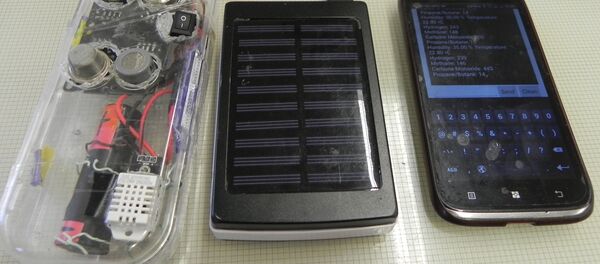MOSCOW (RIA Novosti) — An international group of scientists from MEPhI, ITMO University and Hosei University (Tokyo, Japan) has begun working on a hybrid two-dimensional structure based on graphene and quantum dots with controlled optic and photoelectric properties for use in solar batteries. The project will result in a prototype solar battery more efficient than existing batteries.
Scientists chose graphene, a carbon allotrope consisting of a single layer of atoms, to create a nano-hybrid material with quantum dots. Graphene has unique properties, including high conductivity, which makes it a very promising material for nanoelectronics.
"The main goal of the project," said MEPhI professor Igor Nabiyev, head of the project, "is to create hybrid nanostructures and to study the physical processes that control the charge carrier photogeneration in thin layers of quantum dots on the surface of graphene sheets as well as the non-radiative carrier transfer from quantum dots to graphene."
"We will carry out this research that will give us an understanding of how we can increase the efficiency of the solar batteries we have now. A prototype of a solar battery with greater efficiency than existing batteries will be the final result of the project," MEPhI professor Igor Nabiyev said.
2D-hybrid nanostructures uniting several elements with various functional properties and showing synergy are a potential "building component" for creating new types of nanostructured materials with the needed optical and photoelectric properties. First, it is possible to use the unique properties of quantum dots as an effective energy concentrator in a wide spectral range; and second, the special electrical properties of graphene are used.
READ MORE: MEPhI Researchers Propose Safer Nuclear 'Reactors of the Future'
As professor Alexander Baranov, of the St. Petersburg National Research University of Information Technology, Mechanics and Optics (ITMO), said, the goal of the research team is to form close-packed 2D structures from quantum dots synthesized at MEPhI on a graphene surface and to study the electro-optic properties.
The project will result in a prototype of competitive new-generation photovoltaic (transforming solar light into electricity) systems with higher efficiency due to the multiple exciton generation (collision ionization with carrier multiplication). It will also eliminate "spectral windows" in collecting solar energy, which are the weak point of existing silicon and germanium solar batteries.
"A several-percent increase in the efficiency of new systems compared with the solar batteries used now would be a true breakthrough in creating new sources of renewable energy," Igor Nabiyev said.
According to Nabiyev, "this scientific initiative is an example of cooperation between the Russian universities participating in the Project 5-100 program."


